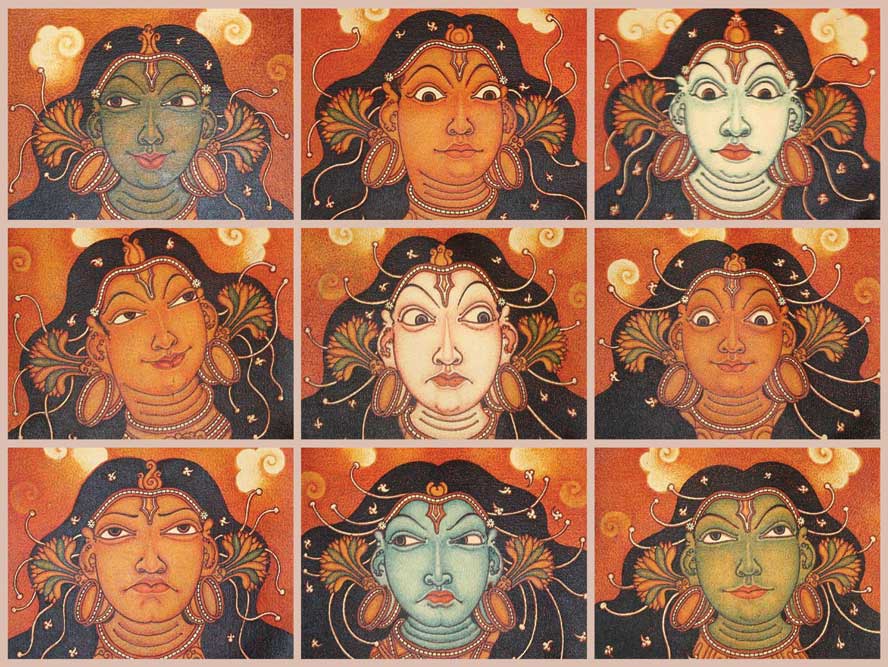The Pedagogy of Kindness
The rewards of a sentimental education
 Sumana Roy
Sumana Roy
 Sumana Roy
Sumana Roy
 |
24 Dec, 2021
|
24 Dec, 2021
/wp-content/uploads/2021/12/Kindness1.jpg)
A thangka of the Jataka Tales, 18th–19th century, Phajoding Gonpa, Thimphu, Bhutan
KINDNESS IS THE highest form of intelligence,” I tell my six-year-old nephew when he asks me why Batul the Great, a superhero in the Bangla comic book he’s reading, is exposing himself to such physical risks for “others”. It’s hard to explain “others” to a child, about the harshness that attends this understanding of the separateness of oneself from the rest of the world. It is even harder to explain why a bumbler—which is what Batul is: a simpleton with little common sense and understanding of the play of causality—who is inadvertently damaging and destroying things should want to help the needy and the wronged.
The little boy is at an age when the performance of physical strength rules his imagination. His parents goad him to study, to rehearse his number and language game—they want to prepare him for a world where the performance of his brain will get him jobs and that pillow called success.
“Kindness is the highest form of intelligence,” I repeat, when he points to the two mischief-making boys being beaten by Batul. Batul has nothing to gain from punishing them, I tell him. It is the farmers whose produce they were stealing that Batul wants to protect.
My nephew isn’t convinced. He knows the words—kindness, love, patience—but they are abstractions for him. It is the visible, sensory and countable world that he inhabits.
Over the next few years—he is ten now—I will look at his books from time to time. He resists this intrusion—he can’t really make out what it is I’m looking for in his books. I don’t quite know it myself. I suppose I’m looking for some sign in his textbooks that tells me that the curriculum is educating him in kindness.
I can’t find any.
His comic book heroes are only slightly better. The American superheroes protect their country and its people from a sense of nationalism, not a sense of kindness. The Japanese cartoon shows that he watches are about the imaginative thrills of technology or trying to escape from helicopter parents. Where is he to get that education from? Certainly not from television, where violence gives blood to news, and, increasingly, fire to gossip.
How does one become kind?
Reading Jatakamala:Stories from the Buddha’s Previous Births, I notice a common emotion—kindness. Whether it’s as king or fish, quail or enchantress, monkey or a king’s banker, the Bodhisattva is driven by kindness to help his fellow beings to be rid of suffering. In one of his incarnations, the Bodhisattva, while wandering through mountains and inside caves with his disciple Ajit, meets a tigress. AND Haksar translates this tale in verse:
There, in a hillside cave, he saw
a young tigress, freshly whelped,
so sick with pain of giving birth,
that she could scarcely move.
She was famished, it was clear,
from her gaunt belly and sunken eyes;
even at her tiny cubs
she stared, as if at food.
Sending Ajit to procure food for the tiger, the Boddhisattva said to himself:
Who should I hunt for flesh,
when all my body is here?
Uncertain is finding another,
it may also impede my duty.
The body is not the self. It is
transient, worthless, home to suffering,
ungrateful, and even unclean.
Not to rejoice at its use for another
is hardly a sign of wisdom ….
Therefore will I cast this wretched
body from the mountainside,
make it lifeless, and thus save
the tiger cubs from their mother
and the tigress from infanticide ….
When will I be able
with these limbs to benefit others?
This old wish I will now fulfil,
and soon attain enlightenment.
I cannot help thinking of their pedagogical effect—how these tales, repeated over and over again, through generations, to children as much to adults, monks and the world dweller, would become an education in kindness, that it was a natural virtue to aspire to. I turned to popular culture and media, hoping to find something comparable. In newspapers, into which the topsoil of the collective conscious drains, I find the opposite—evidence of selfishness, violence against humans and our home, this planet. On television, there is The Ellen Show, where “Be Kind” has been turned into a business—money seems to be the only real way of showing kindness, and those who have been kind in that tradition are rewarded with more money.
If not in their textbooks and extracurricular, surely there must be something in popular culture that could activate the kindness of children? When the superheroes changed from Nanak and Jesus and Moses and Krishna and Allah, the Most Merciful (bi-smi-llahi-r-rahmani r-rahim) to Superman and Spiderman and Ironman, why did kindness become the casualty in the narrative?
Reading Jatakamala, stories from the Buddha’s previous births, I notice a common emotion—kindness. Whether it’s as king or fish, or quail, the bodhisattva is driven by kindness to help his fellow beings to be rid of suffering
I am looking at the curriculum in schools and colleges. I want some sign beyond the theoretical, a sign of the relationship between knowledge—“scholarship”, the bull in the academic stock exchange—and its relationship with kindness. How did guilt replace kindness, and how did that come to happen? I think of the inconsequentiality of guilt and the productivity of kindness; I see Foucault in many course modules, and I see the dissonance between theory and practice—how both the teachers and the taught continue to exercise power from their institutional positions and affiliations, how their words and actions are only fresh iterations of hierarchies that they once set out to dismantle. The contexts might have changed, the arena might be slightly different, but one form of stone pelting has replaced another. Mob lynching on Twitter is a gladiator sport, so much so that the writer Chitra Viraraghavan felt compelled to record it in a tweet: “Gangs of Twitterpur”.
Guilt, particularly as it plays out now, in pedagogy and its attendant fields, is a function of capitalism—it is also in the head-heavy tradition of learning, one that is naturally discriminatory, making, as it does, a difference between the “literate and illiterate”, “educated and uneducated”, the “scholar”, the “pandit”, and the “plebeian”. I use these words in quotes—this is how the academic mocks the less fortunate, those who do not have their benefits of education, those disadvantaged by class, caste, gender, location, and their consequent conditioning. Kindness is a function of its opposite—the word “kind” also provides a suffix to humankind, to look beyond oneself to see one’s relation with the other, with the rest of the world.
How does one educate others in kindness? And how does one educate oneself in kindness? This does seem like a subject demanding autodidacticism—that one must train oneself to be kind. Does this assume that one is not born kind? How does one nurture or incubate a kind imagination? Quite clearly, theoretical reading isn’t enough. Over the past year I have seen scholars who teach race and caste and colonialism, among others, reveal that their theoretical learning wasn’t enough for them to have a kind imagination. I have watched and felt the horror of seeing these venerable academics attack colleagues (colleague seems like a misnomer here, for there is absolutely no sense of collegiality) and I have tried to overcome the trauma of being attacked and belittled by them. Their learning and their scholarship have much to offer the world, I am certain, but it has not been able to produce a kind imagination.
A fault-finding pedagogy has not made us kinder, for fault-finding does not really require the imagination, only skill. It is not hard to see that this fault-finding plays out mostly on the level of language—again, this is often about hierarchy, about those who have access to such a vocabulary and those who have not yet been tutored in it. I’ve watched, with horror, how a linguistic lapse has been turned into a stone pelting opportunity on social media. And I—and many of my friends, including one, who confessed to me that they had contemplated suicide for the manner in which they were trolled (I didn’t confess that I had considered doing the same) —have suffered the trauma of being attacked, all for having a point of view dissimilar to others’. When the doctor asked me what had caused such severe weight loss and ill health, I could not tell him that it was because of trolling. That is still not the name of any illness in their books, I think.

I wait for a return to a pedagogy of kindness—a voltaic imagination enriched by politics, for what else is politics if not a discourse of hope? I wait for a pedagogy of kindness—one that is formed by the belief that “reform” is a variation of “form”, and is predicated on creation, not destruction alone.
While discussing the Plant Humanities with a few students, before they made their presentations at the graduate seminar, Neer, a student, asks about a text that I’ve asked them to read: the scientist Jagadish Chandra Bose’s Plant Autographs.
“As I read about Bose making his plants respond to electric voltage, heat and cold, I felt so sad for the plants,” she said. “Why was it necessary, even if it was for the sake of science and scientific experiment, for the plants to suffer so much just to prove Bose right?” Neer mentioned discussing this with a botanist friend, and how her friend had told her about the extreme conditions the subjects of study are put through, and how it should not be misconstrued as “cruelty”.
What did a discipline like ecocriticism, on which they were to make their seminar presentations, think of this? Or, how did such a field, rooted to the belief in sharing the planet equally, make of its disciplinary distinction between the human and the “non-human”, defining a group through a lack, a negative, the “non”? How would it be possible, after that, to hinge itself to a pedagogy of kindness?
I think of the proximity of Hasya and raudram and Karuna, laughter, anger and grief, in Bharatmuni’s categorisation of the rasas in the Natyashastra, and I am made aware of how someone’s laughter is often another’s anger or sadness
After my niece was born three years ago, I began to feel this more urgently. Captive at home for the last two years, she knows only a few of us first-hand. Her parents and brother, her grandparents, and my husband and myself—her kin. That word, which I’d never used for myself and my associations, came to me as I overheard her mother trying to teach her. A for apple and B for boy … K for King. The three-year-old could understand apple and boy but she, of course, didn’t know who or what a king was. The book of the alphabet is, after all, a book of nouns. A child’s world begins with nouns—with identification of the world around it, moving gradually to verbs (my niece’s first verb was a diminutive for the Bangla word for eating) and then to other parts of speech. Adjectives and abstract nouns, both related to the nature and qualifying characteristics of things, come much later. They rely on assessment that comes from living in the world and being conditioned to it. Changing that would be impossible, of course, but what if there was another book of the alphabet, introduced after the book of nouns, or introduced informally, through stories, by parents, guardians, and their surroundings, that would begin acquainting little children with the afterlives of verbs—their actions. Not a class with the lukewarm ambition of a moral science lesson, but something that derives directly from their lives and its residents, their histories. Stories coded with playfulness.
For instance, instead of “K for King”, what if the last letter was left blank? K for “kin”, a __ left after that. A child could play a game: kinG, kinD. This journey from the noun to the adjective, going through the various meanings of “kind” itself—meaning variety, and so on, all of this turned into a journey of discovery. What brings greater joy—to be a king or to be kind?
I watch the actor Riz Ahmed speak about the cake-cutting ceremony of his childhood. How, on every birthday, after he had cut his birthday cake, his cousins would be given a chance to cut the same cake. The children would sulk at only one person being given the opportunity to cut the cake, and the adults—the child Riz’s parents, and, possibly, uncles and aunts—had come up with this solution. I watched Riz Ahmed narrate this with humour and affection, and I also watched the American host’s response: Jimmy Kimmel could only think of the butchered cake at the end of all that cake-cutting. There are a few lessons in there—not just in the difference in humour, but in where the locus of kindness might be: the children or the cake.
On my birthday this year, my friends—of nearly four decades, since those first days in school—brought me a birthday cake which had the likeness of me sitting and reading my book, How I Became a Tree. I hadn’t seen a cake more beautiful than this, and I was reluctant to cut it. After slicing a slim portion, I kept the remainder of the cake for my niece. When she saw it, she was transfixed. A little later, after she’d been left alone with the cake, the “doll”, as she called it later—the likeness of me—was in her hands, its decapitated body in one hand, the head, half-eaten, in another.
A fault-finding pedagogy has not made us kinder, for fault-finding does not really require the imagination, only skill. It is not hard to see that this fault-finding plays out mostly on the level of language
We laughed and made jokes about cannibalism. Her brother, who often shoots at things in his video games, joined in the laughter. This certainly wasn’t an education in kindness—eating and killing of one’s kind, of all kinds. And yet we laughed.
I think of the proximity of hasya and raudram and karuna, laughter, anger and grief, in Bharatmuni’s categorisation of the rasas in the Natyashastra, and I am made aware of how someone’s laughter is often another’s anger or sadness. The class bully gets a laugh at the expense of the bullied child, who feels only anger and suffering. Our culture, where everything can be turned into a meme, has become forgetful of this. When I mention this to a friend, he gives an interesting reason: “It is because we don’t read novels. Fiction—stories—allows us to imagine other lives and what it means to live like them. Now we only read books for self-help.”
Is it this, then, where it might be—in fiction, a pedagogy of kindness?
What is the location of kindness?
I think of the Upanishad—upa, meaning “by” and ni-sad meaning “sit down”; “sitting down near”. Not its literal implication of sitting near the feet of the teacher, but its metaphorical life that might help us to imagine a kind pedagogy. “Beside”—like Deleuze’s rhizome is “beside”—might enable an imagination of kinship and kindness that other prepositions that drive pedagogy today (“beyond”, “behind”, “below”, and other prepositions where hierarchies are invisible) might not always be able to. To sit down near each other is to be annotated with the impress of community that moves to the rhythm of agreement and disagreement, as I imagine Socrates and Cephalus and Glaucon and others did in Plato’s Republic or Krishna and Arjuna did in the Gita.
This space, without a definite perimeter, without a fixed address, one as accommodative as the human heart or the semicolon, that allows for an unlimited number of attempts at climbing a tree for its mangoes, that might be the location of kindness. To be kind is to be like the earth that does not let us fall off its body, neither those who make mistakes nor those who don’t.
I am unwell. I lie in bed, watching the house move from one end to the other. Or that is how it seems to me as people move about—like molecules changing their position, producing energy. I hear them play, my nephew and niece, I hear the sound of their bats and balls and their disagreements. The pressure cooker whistles for attention, the calling bell rings, mustard seeds splutter—I imagine their prehistories and afterlives.
My nephew comes into the room, blowing bubbles with his bubble-blowing stick. His sister, then two-and-a-half years old, chases the bubbles with her entire being. She calls out to me, asking for attention, not towards her, but for those bubbles rising and falling, always bursting. Suddenly she climbs on the bed urgently.
Her hands are cupped.
“Bubble,” she says, gifting me one.
The bubble has, of course, died in her palms, much before it could reach me.
We look at her hands, where the bubble was, imagining it. Then we look at each other—the giver and receiver of a bubble.
I remember my tears—the little girl’s kindness that makes her want to share an un-shareable thing like a bubble with someone who is weak and unwell and stationary.
Whether it is kindness that makes possible this imagination or the imagination that nudges kindness I do not know. What I do know is just this—the radical politics of such a kind imagination that believes that sharing a bubble is not impossible.

/wp-content/uploads/2025/05/Cover-War-Shock-1.jpg)












More Columns
Don’t bankroll terror, India tells IMF as it approves new $2.3 bn loan to Pakistan Open
What It Means to Have an American Pope Open
IPL suspended for a week due to India-Pak tensions Aditya Iyer